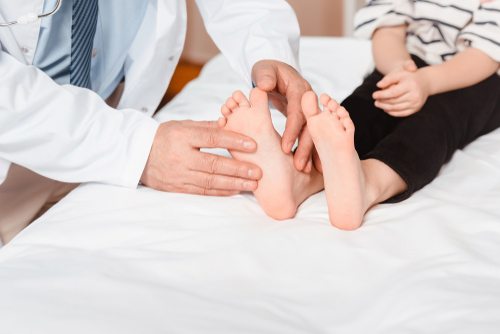Pediatric Flat Feet
Flat feet, or feet without an arch, are extremely common in children. In fact, all kids’ feet are flat at early stages of normal development. Therefore, most cases of flat feet in children are not painful or problematic and will resolve over time. However, some children’s feet will never develop an arch. While most of these remain flexible and do not become symptomatic, there are several types of flat feet that become painful and affect a child’s ability to remain active.
Pediatric Flexible Flat Feet
The vast majority of flat feet in kids are flexible. This means that the joints in the foot move freely, and an arch can be created by positioning the foot with one’s hands. This is called pediatric flexible flat foot and is rarely a problem for the child. Children with flexible flat feet are able to walk and run like other children in their age group and demonstrate no limp or abnormal complaints of being tired while walking long distances.
Most of these children also have tight Achilles tendons or calf muscles, known as “Equinus’, which contributes to the condition. When the calf muscle is tight, the ankle cannot flex up properly while walking, causing the foot to turn out to the side or “flatten”. This type of flat foot is easily treated with arch support and calf stretches. The worst cases of flexible flat foot, known as “calcaneovalgus”, may require a series of casts to straighten the foot sufficiently prior to treating with arch support. Very few cases of pediatric flexible flat foot become symptomatic despite conservative treatment and may require surgery to lengthen the Achilles tendon, implant a device to prevent flattening, or reconstruct the arch.
Tarsal Coalition
The most common cause of rigid flat foot in children is tarsal coalition. This occurs when two or more bones in the hindfoot do not develop properly, causing the foot to become fixed in a flat position. This type of flat foot does become painful over time due to the limited motion and resulting abnormal gait. Severe muscle spasms often occur and neighboring joints become arthritic. Children complain of pain while walking or running and cannot keep up with other kids. This type of flat foot may respond to stretching and arch support or may require surgery to mobilize the joints, reconstruct the foot to create an arch and lengthen the Achilles tendon. Arch support is always recommended after flat foot surgery.

Vertical Talus
Vertical talus is an uncommon form of rigid flat foot which is recognized at birth. The foot is fixed in a severely flattened position and cannot be manually mobilized or corrected. This rare condition requires surgery at an early age followed by casting, physical therapy, splints and arch supports once the child begins to walk.
Treatment of Pediatric Flat Feet
While flat feet in children usually represent normal development, there are cases which will require treatment. Therefore, it is important to see one of the board-certified podiatrists at Certified Foot and Ankle Specialists if your child demonstrates flat feet that do not develop an arch over time, the foot is rigid or if the child complains of pain or asks to be carried more than other kids. Fortunately, treatment options are available for all types of flat feet in kids so that they may go on to live healthy and active lives.